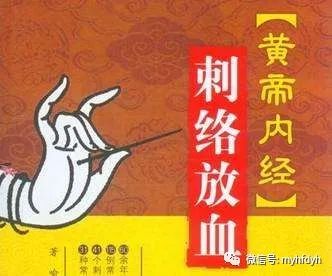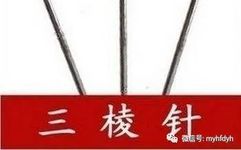1. What is Bloodletting Therapy?
Bloodletting therapy, known as cì luò fàng xuè (刺络放血), is a unique acupuncture treatment method in Traditional Chinese Medicine (TCM). It is one of the most commonly used therapeutic techniques since the era of the Nei Jing (内经), which even considers bloodletting as the first choice for treating diseases and alleviating pain. Depending on the patient’s specific condition, a three-edged needle or a thick, sharp needle is used to puncture certain acupuncture points or superficial blood vessels on the patient, allowing a controlled amount of blood to be released to achieve therapeutic effects.

2. Cultural History and Effects of Bloodletting:
Bloodletting therapy has a long and rich history in China and is widely practiced in folk medicine. This therapy is characterized by its simplicity, ease of learning, rapid effectiveness, high efficacy, and safety. It is effective not only for many common and frequently occurring diseases but also has unexpected effects on certain difficult conditions.
3. Modern Research on Bloodletting Therapy:
Modern studies summarize the following effects of bloodletting therapy: it has a beneficial bidirectional regulatory effect on the blood system. Research indicates that bloodletting can promote human metabolism, stimulate bone marrow hematopoiesis, accelerate metabolism, and improve microcirculation and vascular function through neuro-humoral regulation, facilitating the elimination of harmful substances from the blood while ensuring beneficial substances are replenished into the circulation, thus helping the body re-establish homeostasis and restore normal physiological functions. By improving microcirculation, it can also prevent excessive inflammatory responses and promote recovery from inflammation.
4. What Problems Can Poor Shoulder and Neck Health Cause?
The shoulder and neck region is the main pathway for blood flow to the head and face. TCM suggests that the best way to regulate women’s health is to ensure smooth circulation of qi and blood. If the flow of qi and blood is obstructed, toxins can accumulate in the shoulder and neck, leading to stiffness.
When toxins accumulate in the shoulder and neck, they can compress blood vessels, hindering proper blood flow to the head and face, which may result in dizziness, headaches, insufficient oxygen supply to the brain, fatigue, decreased sleep quality, memory decline, and can also cause facial discoloration, darkening, spots, and skin aging.
5. Why is the Shoulder and Neck Area Considered the First to Age?
Because the body’s circulation flows from top to bottom, when there are high levels of toxins in the body, the first area where toxins accumulate is the shoulder and neck, which is a crossroads for the body. Accumulation of toxins can lead to stiffness and aging in this area. When the shoulder and neck are blocked, it can cause insufficient nourishment to the pituitary gland in the brain, impairing the secretion of growth and reproductive hormones, especially in women, which can directly lead to endocrine disorders and early onset of menopause.
6. Current Status of Shoulder and Neck Syndrome:
According to statistics from the World Health Organization, 60% of people aged 30 have varying degrees of cervical spondylosis; 80% of people aged 40 have varying degrees of cervical diseases; and 100% of people over 60 have varying degrees of cervical spondylosis.
Common populations affected by shoulder and neck issues include:
1. Individuals with a lack of exercise, prolonged computer use, and those in specific occupations with heavy backpacks;
2. Those wearing heavy earrings, high heels, engaging in long phone calls, or playing mahjong;
3. Activities such as washing hair while lying back, wearing tight undergarments, poor sitting posture, and bad sleeping positions can lead to shoulder and neck problems at any age;
Scientific research has proven that any area of strain or blocked meridians has varying degrees of residual toxins. Only by thoroughly eliminating these residual toxins can the root cause of the strain be addressed, and the best way to achieve this is through bloodletting therapy.

7. Principles of Back Bloodletting:
By using herbal fire therapy to expel deep-seated dampness and cold from the body, combined with TCM techniques to repeatedly stimulate the areas of strain and blockage, the accumulated lactic acid and nodules can be broken down. In severely strained and blocked areas, plum blossom needles (梅花针) are used for rapid puncturing to thoroughly expel the residual toxins and stagnant blood from deep within the body, achieving immediate improvement and treatment of shoulder and neck diseases.
By analyzing the color of the blood sample, you can gain a clear understanding of your health status—what category do you belong to?
1. Dark black blood indicates chronic illness, suggesting long-term stagnation of blood and blockage of channels;
2. Blood mixed with water indicates rheumatism or liver disease;
3. Blood containing jelly-like mucus indicates dampness and toxin accumulation over time;
4. Light blood indicates inflammation or early-stage illness; purple-red blood indicates a new injury;
5. If the extracted fluid resembles wash water, it indicates severe chronic dampness;
6. Clear watery fluid indicates edema;
7. Presence of bubbles indicates heavy dampness;
8. Foamy liquid suggests wind pathogen;
9. A large volume of blood extracted indicates a long illness duration;
10. A small volume of blood indicates a short illness duration or deep-seated condition;
11. If you feel a rush of heat when reaching into the cup after cupping, it indicates heavy damp-heat;
12. Slow bleeding, even after multiple punctures, suggests qi deficiency and blood deficiency;
13. Light bleeding that does not coagulate easily indicates blood deficiency;
14. Blood that settles quickly and coagulates easily indicates qi deficiency.
You may also like the following content:
Abdominal massage video explanation
Chest lymphatic detox techniques
Back massage technique video
Techniques for treating ‘wealth bag’ (富贵包)
Breast health techniques video
Heart and lung maintenance techniques tutorial
Back and waist mud moxibustion operation techniques video
Lumbar manipulation massage techniques
Abdominal massage techniques video
Ovarian health techniques video
Waist techniques video tutorial
Chinese foot reflexology techniques
Armpit lymphatic detox techniques tutorial
Complete video tutorial on hair washing techniques
Kidney health techniques tutorial
Abdominal weight loss techniques video
Leg massage techniques video
Head scraping techniques video
Abdominal massage techniques tutorial
Shoulder blade pushing techniques video
Don’t be shy, women with strong reproductive functions share these two common traits; if you possess both, congratulations!
The differences in bodily changes between those who are sexually active and those who are not are significant!
Reproductive health: After intimacy, should women urinate or not?
How to maintain health based on different body types?
Follow the public account below to learn beauty industry sales techniques:
Follow the public account below to learn professional knowledge in the beauty industry:

